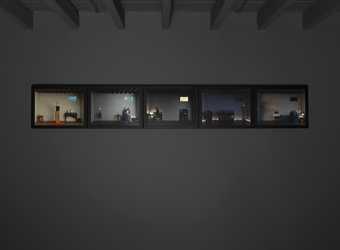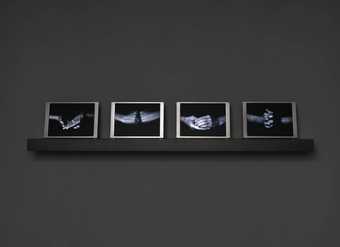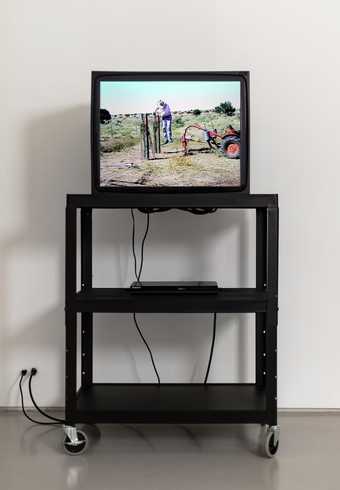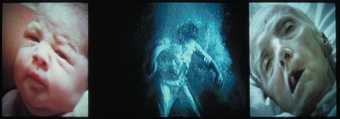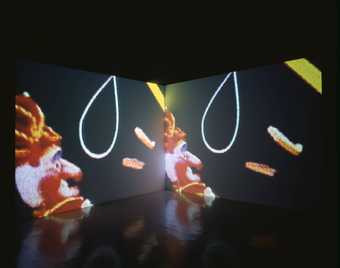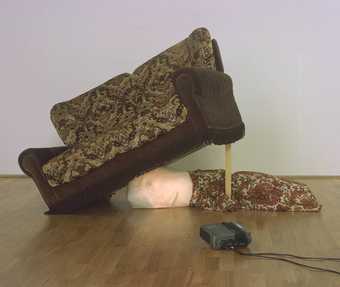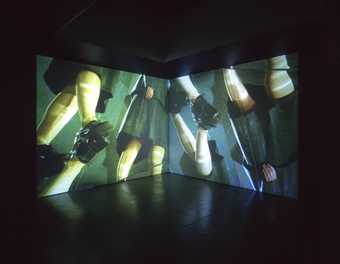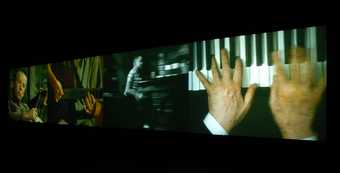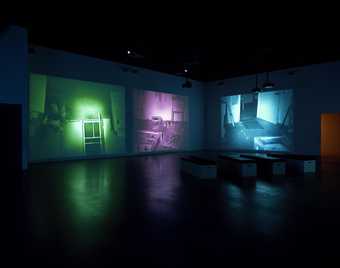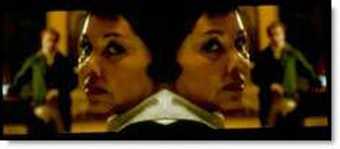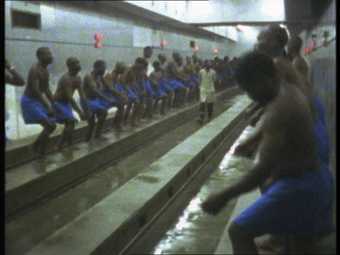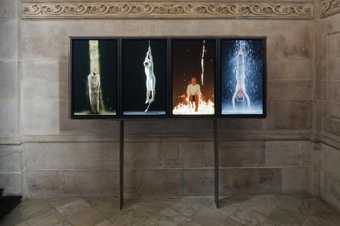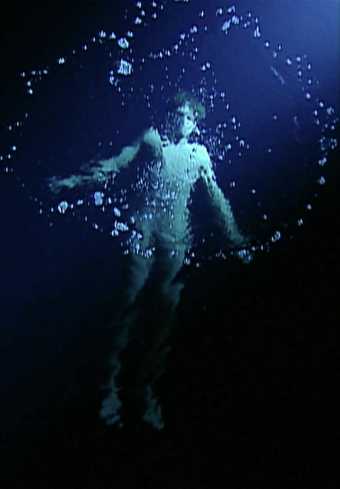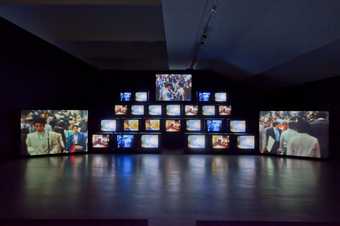
Not on display
- Artist
- Bill Viola born 1951
- Medium
- Video, 5 projections, colour and sound (stereo)
- Dimensions
- Collection
- Tate
- Acquisition
- Purchased jointly by Tate, London courtesy of Lynn Forester de Rothschild, the Whitney Museum of American Art, New York courtesy of Leonard Lauder, and the Centre Pompidou, Paris courtesy of Lily Safra, 2003
- Reference
- T11805
Summary
Five Angels for the Millennium is an installation comprising five videos projected at a large scale directly onto the walls of a dark gallery space. The videos are individually titled Departing Angel, Birth Angel, Fire Angel, Ascending Angel and Creation Angel. Each video features a clothed male figure rising out of and plunging into a pool of water at irregular intervals, as well as hovering over it in between these movements. In all five films the action is presented in slow motion, and in each one the man and the water are shown in a single colour that changes over time in each film between a range of blue and green tones and a dark, blood red. These hues are accentuated by contrasting areas of bright white and pitch black. The five videos play simultaneously, but they are not synchronised and each is repeated on a continuous loop, so that the figures are seen repeatedly moving in and out of the water. Each projection is accompanied by an individual audio track featuring underwater noises that gradually reach a crescendo that culminates in ‘a sudden explosion of light and sound’ as the figure emerges from the water (Viola in J. Paul Getty Museum 2003, p.146).
This work was made in 2001 by the American artist Bill Viola in his studio in Long Beach, California. Viola filmed the footage for the piece in 2000 in collaboration with the American cinematographer Harry Dawson. Each video was filmed separately and although the location of the filming is unknown, it is the case that all of them were recorded during the production of another work by Viola, The World of Appearances 2000 (Helaba Main Tower, Frankfurt), which is also a large video piece that centres on a man plunging into a pool of water. When he had finished filming Five Angels for the Millennium Viola selected the sections of footage that he wanted to use, which each lasted between thirty-five and forty seconds. He then colour-corrected them and slowed them down, before reframing them and fine-tuning their speed so that the figures would emerge and descend in time with the pattern that he had devised. Viola has stated that he initially worked out the timing of the five videos ‘on graph paper as a kind of visual score’ (Viola in J. Paul Getty Museum 2003, p.216). Furthermore, Viola has compared the structure of the repeating films with that of a fugue, a type of musical composition in which single themes are repeated using multiple voices and musical variations.
The work’s title suggests that the five figures are angels who have a specific relationship to the new millennium, which had just begun when this installation was being filmed and edited. As such, the work may invite reflection on the state of religious or spiritual belief at the dawn of a new era. Viola has often drawn on the history of religious art in his work, and has sought to evoke strong spiritual feelings through his installations’ imagery and sound. He has stated that Five Angels for the Millennium produces ‘an enveloping emotional experience like that of a church’ and that it is about what ‘you cannot see, the things that are not on the surface’ (quoted in J. Paul Getty Museum 2003, pp.48, 216). Although raised as an Episcopalian, Viola was interested in world religions from an early age and he has often suggested that his practice is driven by a broad interest in the existence of a spiritual realm, rather than by the creed of any particular faith. In 1997, three years before he began making Five Angels for the Millennium, Viola explained:
I guess the connection ultimately ... has to do with an acknowledgement or awareness or recognition that there is something above, beyond, below, beneath what’s in front of our eyes, what our daily life is focused on. There’s another dimension that you just know is there, that can be a source of real knowledge, and the quest for connecting with that and identifying that is the whole impetus for me to cultivate these experiences and to make my work. And, on a larger scale, it is also the driving force behind all religious endeavors. There is an unseen world out there and we are living in it.
(Quoted in Bill Viola, exhibition catalogue, Whitney Museum of American Art, New York 2000, p.143.)
Viola has also specifically compared the spiritual themes of Five Angels for the Millennium to his work Passions 2000–ongoing, a series of video installations featuring footage of actors displaying various emotions (see J. Paul Getty Museum 2003, p.48). When making Passions, Viola drew on diverse sources from Eastern and Western religious art that depict emotional states.
Water has been a recurring motif in Viola’s videos throughout his career, for instance in The Reflecting Pool 1977–80 (Art Institute of Chicago, Chicago), Nantes Triptych 1992 (Tate T06854) and Going Forth by Day 2002 (Solomon R. Guggenheim Museum, New York). The art historian John Walsh has argued that the water in Five Angels for the Millennium plays a significant role in expressing Viola’s spiritual concerns by evoking ‘a luminous void of unknown dimensions where the laws of physics seem suspended and the borders between the infinite cosmos and the finite human body merge’ (J. Paul Getty Museum 2003, p.146).
Further reading
Bill Viola: The Passions, exhibition catalogue, J. Paul Getty Museum, Los Angeles 2003, pp.48–50, 146, 183–4, 216–20, 254, reproduced pp.48, 146–55, 270.
Chris Townsend (ed.), The Art of Bill Viola, London 2004, pp.7, 20–1, 37–8, 42, 59, 75, 143, 145, 151, 156–9, 177–9, reproduced pp.6, 157, 176.
‘Bill Viola: Artist’s Talk’, 16 June 2006, http://www.tate.org.uk/context-comment/video/bill-viola-artists-talk, accessed 30 May 2014.
Natasha Adamou
June 2014
Supported by Christie’s.
Does this text contain inaccurate information or language that you feel we should improve or change? We would like to hear from you.
Explore
- emotions, concepts and ideas(16,416)
-
- formal qualities(12,454)
-
- photographic(4,673)
- recreational activities(2,836)
-
- diving(26)
- Bible: New Testament(545)
-
- Ascension(4)
- angel(267)
- birth to death(1,472)
You might like
-
Bill Viola Catherine’s Room
2001 -
Bill Viola Four Hands
2001 -
Bruce Nauman Setting a Good Corner (Allegory and Metaphor)
1999 -
Bill Viola Nantes Triptych
1992 -
Susan Hiller An Entertainment
1990 -
Tony Oursler The Most Beautiful Thing I’ve Never Seen
1995 -
Jane and Louise Wilson Gamma
1999 -
Christian Marclay Video Quartet
2002 -
Sir Isaac Julien CBE RA Vagabondia
2000 -
Sir Steve McQueen Caribs’ Leap/Western Deep
2002 -
Susan Hiller Psi Girls
1999 -
Bill Viola Martyrs (Earth, Air, Fire, Water)
2014 -
Bill Viola The Messenger
1996 -
Gretchen Bender Total Recall
1987

